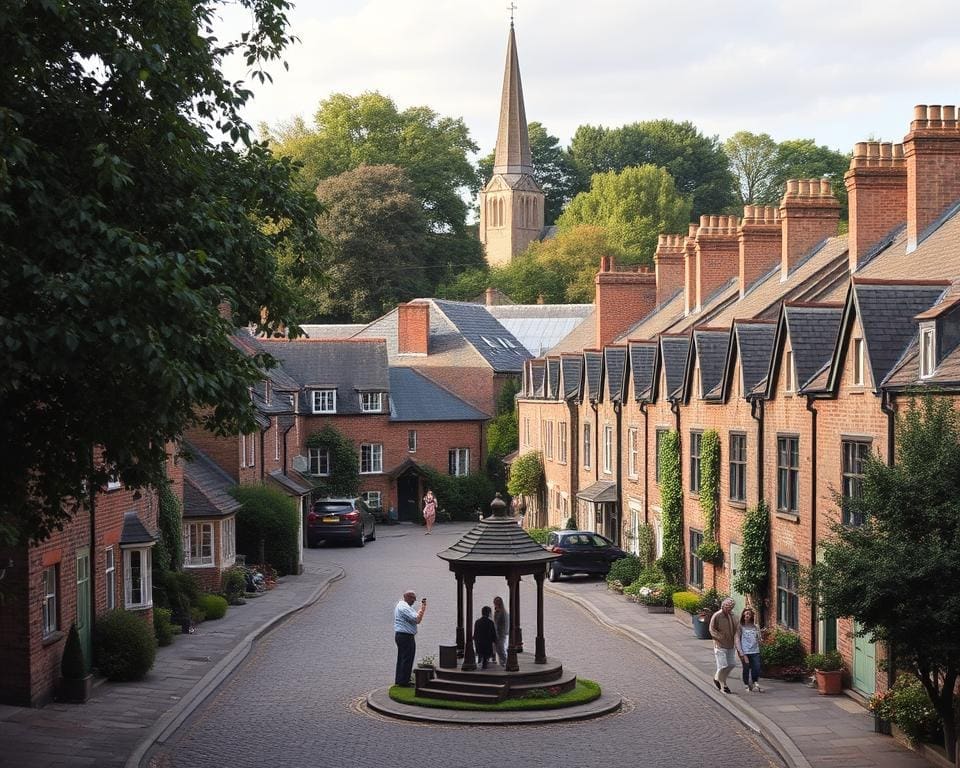Navigating the intricate fabric of England’s conservation neighbourhoods requires a keen understanding of what’s allowed within these historically significant areas. These neighbourhoods are not only vital for preserving architectural heritage but also serve to maintain the cultural integrity of our communities. Residents must be aware of the activities permitted in conservation areas to ensure compliance with local regulations while honouring the distinct charm and character of their surroundings. By grasping these guidelines, individuals can contribute positively to the preservation of their heritage and the beauty of their neighbourhoods.
Understanding Conservation Neighbourhoods in England
Conservation neighbourhoods in England represent a vital aspect of urban and rural planning, aimed at safeguarding unique local heritage. These areas reflect a rich tapestry of history and culture, serving as a testament to the architectural styles and traditions of bygone eras. The legal definitions surrounding these neighbourhoods not only clarify their boundaries but also establish frameworks for their protection and enhancement.
The importance of conservation areas can hardly be overstated. They play a critical role in retaining distinctive local features such as historic buildings, unique street patterns, and open spaces that contribute to a community’s character. This dedication to heritage preservation ensures that future generations can engage with their local history, fostering a sense of belonging and identity.
Legal frameworks governing conservation neighbourhoods provide essential guidelines for development and renovation. By emphasising preservation, these regulations support sustainable community development while honouring the architectural heritage that shapes daily life. Understanding and respecting these guidelines is crucial for residents, as they empower them to contribute positively to their surroundings while maintaining the essence of their neighbourhoods.

What’s allowed in England’s conservation neighbourhoods?
Conservation neighbourhoods in England are spaces treasured for their architectural charm and historical significance. Understanding the allowed activities in conservation areas is crucial for maintaining these unique environments. Residents must navigate conservational regulations designed to protect the character of their neighbourhoods while engaging in everyday life and home improvements.
Defining Allowed Activities
In conservation areas, specific activities are permissible, focusing on preserving the original aesthetic and architectural features. Commonly allowed activities include:
- Minor renovations that respect the building’s historical style
- Routine maintenance without altering the external appearance
- Landscaping that incorporates native species
- Installation of energy-efficient measures that blend with the environment
These activities support the delicate balance between modern living and historical preservation. Residents planning alterations should be aware of the necessity to adhere strictly to conservational regulations to ensure their projects contribute positively to the community’s heritage.
Key Considerations for Residents
Before embarking on any home improvements, residents’ considerations play a vital role in the success of projects within conservation areas. Key points to consider include:
- Obtaining the required permissions before beginning any construction or alteration
- Understanding the potential impact on property values associated with renovations
- Engaging with the community and local authorities for guidance and support
Additionally, sustainable practices are encouraged, ensuring that enhancements harmonise with the local environment. By respecting these guidelines, residents will not only ensure compliance with local regulations but also enrich the community’s unique character.
Rules for Conservation Areas in England
The framework governing conservation areas in England is vital for safeguarding the unique architectural and cultural heritage that defines these communities. The implementation of rules for conservation areas in England is largely guided by the Town and Country Planning Act. Understanding the legal restrictions in conservation areas is essential for anyone residing within or developing properties in these zones.
Legal Restrictions and Their Importance
Compliance with legal restrictions in conservation areas protects not only individual buildings but also the character of neighbourhoods. Such restrictions include rules against unsympathetic developments that may alter the visual integrity of the area. Homeowners must be aware of the jurisdiction of conservation laws when considering renovations or new construction. Failing to adhere to these rules can lead to serious penalties including fines and enforcement actions aimed at preserving the cultural significance of the area.
Engaging with the planning authorities can provide clarity on what modifications are permissible, ensuring that any development aligns with community standards and conservation objectives. Understanding these regulations enhances the ability to maintain the historic character, ultimately benefiting both residents and visitors alike.
Permitted Developments in Conservation Zones
Conservation zones present a unique blend of protection and opportunity for homeowners. While many assume that strict regulations stifle development, there exists a range of permitted developments in conservation zones that allow for thoughtful upgrades and enhancements. Understanding these possibilities can inspire residents to preserve their properties while enhancing their functionality.
Common Examples of Permitted Developments
Homeowners in conservation areas often enjoy certain leeway when it comes to improvements. Some common examples of permitted developments include:
- Minor home extensions that comply with specific size and design criteria
- Repairs and maintenance using traditional materials that match the original aesthetic
- Garden structures, such as sheds or greenhouses, designed to be unobtrusive
These permitted developments not only maintain the character of the conservation area but also allow residents to enjoy modern conveniences and improvements.
Exemptions and Special Permissions
Exemptions in conservation areas can often apply to certain types of properties, particularly listed buildings. In these cases, specific alterations may be permitted if they align closely with historical aesthetics. This could involve minor modifications that ensure the building’s integrity remains intact. Furthermore, homeowners may seek special permissions for implementations like solar panels or other sustainable installations. These advancements can help balance preservation with contemporary environmental needs.
Building Regulations in Conservation Neighbourhoods
Understanding building regulations in conservation neighbourhoods is vital for ensuring that any construction adheres to the unique character of the area. These regulations serve as a framework designed to protect the historical integrity and aesthetic value of conservation areas while guaranteeing the safety and well-being of residents.
These construction rules in conservation areas aim to maintain the architectural uniformity that characterises many of these neighbourhoods. Compliance with building codes not only ensures structural integrity but enhances the local environment. Homeowners contemplating alterations or new constructions should familiarise themselves with the specific building regulations that apply to their locality.
Furthermore, the interplay between various regulations may require collaboration with local authorities to achieve compliance. Consequently, residents must engage in thorough planning to navigate the complexities of local legislation. This proactive approach benefits both the individual and the community, preserving the charm that makes conservation neighbourhoods so special.
Planning Permission in Conservation Areas
Obtaining planning permission in conservation areas can often be an intricate process. It requires careful navigation through the necessary steps to secure the right to alter or develop property within these protected zones. Understanding the nuances involved in the application process for conservation zones proves essential for homeowners and developers alike.
Understanding the Application Process
The application process for conservation zones begins with the submission of a detailed proposal to the local planning authority. Applicants must include essential documents such as design statements, which illustrate how any proposed changes will harmonise with the area’s character. It’s vital to consider including conservation assessments that demonstrate respect for local heritage.
Engaging with local authorities early in the process can unveil potential concerns or requirements that need addressing. Taking this step can assist in mitigating objections and facilitating the granting permissions necessary for successful applications. Each conservation area has unique regulations, making it crucial to be well-informed about the specific guidelines applicable to your locality.
- Prepare a comprehensive design statement.
- Conduct a thorough conservation assessment.
- Engage with the community to gauge support and address any worries.
The intricacies of planning permission in conservation areas require attention to detail and a proactive approach. By following these guidelines, individuals can work towards achieving their goals while preserving the valuable characteristics of their surroundings.
Guidelines for Conservation Neighbourhoods in England
Homeowners living in conservation neighbourhoods hold a vital role in preserving the historical fabric and character of their communities. Understanding the guidelines for conservation neighbourhoods in England is essential for maintaining this invaluable heritage. Adopting best practices for conservation areas ensures that renovations and restorations align with the unique architectural styles and historical significance of the area.
Best Practices for Homeowners
To effectively contribute to the conservation efforts, homeowners should consider the following best practices:
- Engage with preservation experts: Consulting specialists in historical building conservation can provide invaluable insights into appropriate methods and materials for renovations.
- Sourcing appropriate materials: Using traditional materials that match the original architecture is crucial. This maintains the aesthetic and historical integrity of the neighbourhood.
- Prioritise restoration over alteration: Focus on restoring historical features instead of replacing them unless absolutely necessary. This preserves the original charm of the property.
- Understand local guidelines: Familiarising oneself with local conservation policies helps in making informed decisions regarding any proposed changes.
- Engage with the community: Building relationships with neighbours and participating in local conservation initiatives fosters a shared sense of responsibility.
These steps highlight homeowners’ responsibilities to safeguard the heritage within their conservation neighbourhoods. By implementing these guidelines, residents can take pride in their homes while contributing positively to the overall character of their community.
Maintaining Local Heritage and Character
Engagement within the community plays a pivotal role in maintaining local heritage and preserving character in conservation areas. By fostering strong connections among residents, these efforts ensure a collective commitment towards the protection of unique architectural and cultural features that define their neighbourhoods.
Community Engagement in Conservation Areas
Initiatives that encourage community engagement in conservation areas help cultivate awareness and appreciation for local history and architecture. Residents can participate in various activities, such as:
- Organising workshops aimed at educating community members about the significance of maintaining local heritage.
- Hosting events that celebrate local traditions, fostering a sense of belonging and pride among residents.
- Collaborating with local councils and preservation societies to advocate for projects that enhance the area’s appeal while respecting its historical context.
Active participation in these initiatives can significantly influence the success of community efforts. Involvement strengthens ties among neighbours, motivating them to preserve character and treasure the distinctive elements of their surroundings.
Practical Tips for Residents of Conservation Areas
Living in conservation neighbourhoods comes with its unique set of joys and responsibilities. One of the fundamental practical tips for conservation area residents is to familiarise themselves with local regulations. Understanding what is permissible can help avoid unnecessary complications, especially when considering renovations or alterations. Always consult the planning authority for specific guidelines relevant to your property and area.
Homeowners should also recognise the importance of maintaining the aesthetic value of their properties. Simple measures, such as using traditional materials for repairs and respecting original architectural features, can significantly enhance the charm of the neighbourhood. Engaging local craftsmen who understand the architectural heritage can ensure that improvements are in harmony with the surrounding environment.
Moreover, residents are encouraged to actively participate in community groups focused on conservation and local history. Such involvement not only strengthens community ties but also cultivates a shared responsibility among homeowners for the preservation and enhancement of their neighbourhood’s character. By embracing these practical tips, residents can enrich their experience of living in conservation areas while contributing positively to the community.









